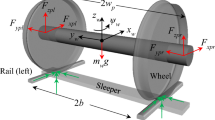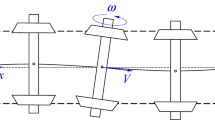Abstract
The maximum speed of a high-speed train is limited to its critical speed. In this study, the definition of critical speed is reviewed. The relationship between creepage and creep force and the effects of the parameters of the first and second suspension systems are also studied using a bogie model to increase the critical speed. Kalker’s linear creep theory and its modification of Wormey’s saturation constant are reviewed. The nonlinear creep force of Vermeulen’s creep theory, Polach’s calculation, and the newly calculated longitudinal and lateral creep forces using strip theory from wheel-rail contact pressure are investigated for the critical speed. Flange contact is also considered when lateral displacement exceeds the dead band between wheel flange and rail. Direct numerical integration and a shooting algorithm are devised to calculate the response, especially for the limit cycle. Results show that as speed increases, the equilibrium point becomes unstable and creates a limit cycle through a Hopf bifurcation. The unstable fixed point can be a critical speed. The critical speed increases as the creep curve becomes stiff before saturation, which is more effective than the variation in suspension parameters. The consideration of flange contact can also increase the critical speed.
Similar content being viewed by others
References
N. K. Cooperrider, The hunting behavior of conventional railway trucks, Journal of Manufacturing Science and Engineering, 94 (2) (1972) 752–762.
R. R. Huilgol, Hopf-Friedrichs bifurcation and the hunting of a railway axle, Quarterly PMM Journal of Applied Mathematics and Mechanics, 12 (1978) 85–94.
M. Ahmadian and S. Yang, Hopf bifurcation and hunting behavior in a rail wheelset with flange contact, Nonlinear Dynamics, 15 (1998) 15–30.
J. Zeng, W. H. Zhang, H. Y. Dai, X. J. Wu and Z. Y. Shen, Hunting instability analysis and H8 controlled stabilizer design for high speed railway passenger car, International Journal of Vehicle Mechanics and Mobility, 29 (1) (1998) 655–668.
W. Chung and S. Kim, A study on the critical speed of railway vehicles, Transaction of KSME A, 24 (8) (2000) 1991–1999.
P. Kim and J. Seok, Bifurcation analysis on the hunting behavior of a dual-bogie railway vehicle using the method of multiple scales, Journal of Sound and Vibration, 329 (2010) 4017–4039.
S. Y. Lee and Y. C. Cheng, Hunting stability analysis of high-speed railway vehicle trucks on tangent tracks, Journal of Sound and Vibration, 282 (2005) 881–898.
Y. C. Cheng, S. Y. Lee and H. H. Chen, Modeling and nonlinear hunting stability analysis of high-speed railway vehicle moving on curved tracks, Journal of Sound and Vibration, 24 (3) (2009) 139–160.
S. Y. Lee and Y. C. Cheng, Nonlinear analysis on the hunting stability of high speed railway vehicle trucks on curved tracks, Journal of Vibration and Acoustics, 127 (2005) 324–332.
J. Park, H. Koh and N. Kim, Parametric study of lateral stability for a railway vehicle, Journal of Mechanical Science and Technology, 25 (7) (2011) 1657–1666.
D. Bigoni, H. True and A. P. Engsig-Karup, Sensitivity analysis of the critical speed in railway vehicle dynamics, International Journal of Vehicle Mechanics and Mobility, 52 (1) (2014) 272–286.
J. W. Jang, S. G. Baek, S. W. Lee, Y. S. Choi and J. C. Koo, Optimization of high speed EMU suspension parameters for vibration reduction, Journal of Mechanical Science and Technology, 27 (2) (2013) 305–311.
J. Pombo, J. Ambrósio and M. Silva, A new wheel-rail contact model for railway dynamics, International Journal of Vehicle Mechanics and Mobility, 45 (2) (2007) 165–189.
S. Zhang, S. Sun and X. Jin, Numerical simulation of twopoint contact between wheel and rail, Acta Mechanica Solida Sinica, 22 (4) (2009) 352–359.
V. K. Garg and R. V. Dukkipati, Dynamics of railway vehicle systems, Academic Press Canada (1984).
D. Horak and D. N. Wormley, Nonlinear stability and tracking of rail passenger trucks, Journal of Dynamic Systems, Measurement and Control, 104 (3) (1982) 256–263.
P. J. Vermeulen and K. L. Johnson, Contact of nonspherical elastic bodies transmitting tangential forces, Journal of Applied Mechanics, 86 (1964) 338–340.
O. Polach, A fast wheel/rail forces calculation computer code, Vehicle System Dynamics, 33 (1999) 728–739.
J. Halling, Micro-slip between a rolling element and its track arising from geometric conformity and applied surface tractions, Journal of Mechanical Engineering, 6 (1) (1964) 64–74.
SAMCEF 8.3, SAMTECH (2010).
S. H. Han, Dynamics analysis of railway vehicle with creep, M.S. Thesis, Sungkyunkwan University (2014).
N. N. Bogoliubov and Y. A. Mitropolsky, Asymptotic method in the theory of nonlinear oscillations, Hindustan Publishing, India (1961).
Author information
Authors and Affiliations
Corresponding author
Additional information
Recommended by Associate Editor Eung-Soo Shin
Yeon-Sun Choi received his B.S. degree from Seoul National University in 1976, his M.S. degree from Korea Advanced Institute of Science and Technology in 1978, and his Ph.D. degrees from Texas A&M University, U.S.A, in 1997. He was vice president of the Korean Society for Railway and the Korean Society for Noise and Vibration Engineering, as well as president of the Dynamics and Control Division of the Korean Society of Mechanical Engineers. He is currently a professor at School of Mechanical Engineering, Sungkyunkwan University, Suwon, Korea. His research interests are nonlinear vibration and fault diagnosis of mechanical systems.
Bum Sik Shin received his B.S. degree from Sungkyunkwan University, Suwon, Korea, in 2005 and his M.S. degree from Sungkyunkwan University, Suwon, Korea, in 2007. He is currently a Ph.D. candidate at School of Mechanical Engineering, Sungkyunkwan University, Suwon, Korea. His current research interests include vibration reduction for high speed electric multiple units under development and the structural characteristics of railway vehicle floors.
Rights and permissions
About this article
Cite this article
Choi, YS., Shin, BS. Critical speed of high-speed trains considering wheel-rail contact. J Mech Sci Technol 29, 4593–4600 (2015). https://doi.org/10.1007/s12206-015-1004-2
Received:
Revised:
Accepted:
Published:
Issue Date:
DOI: https://doi.org/10.1007/s12206-015-1004-2




